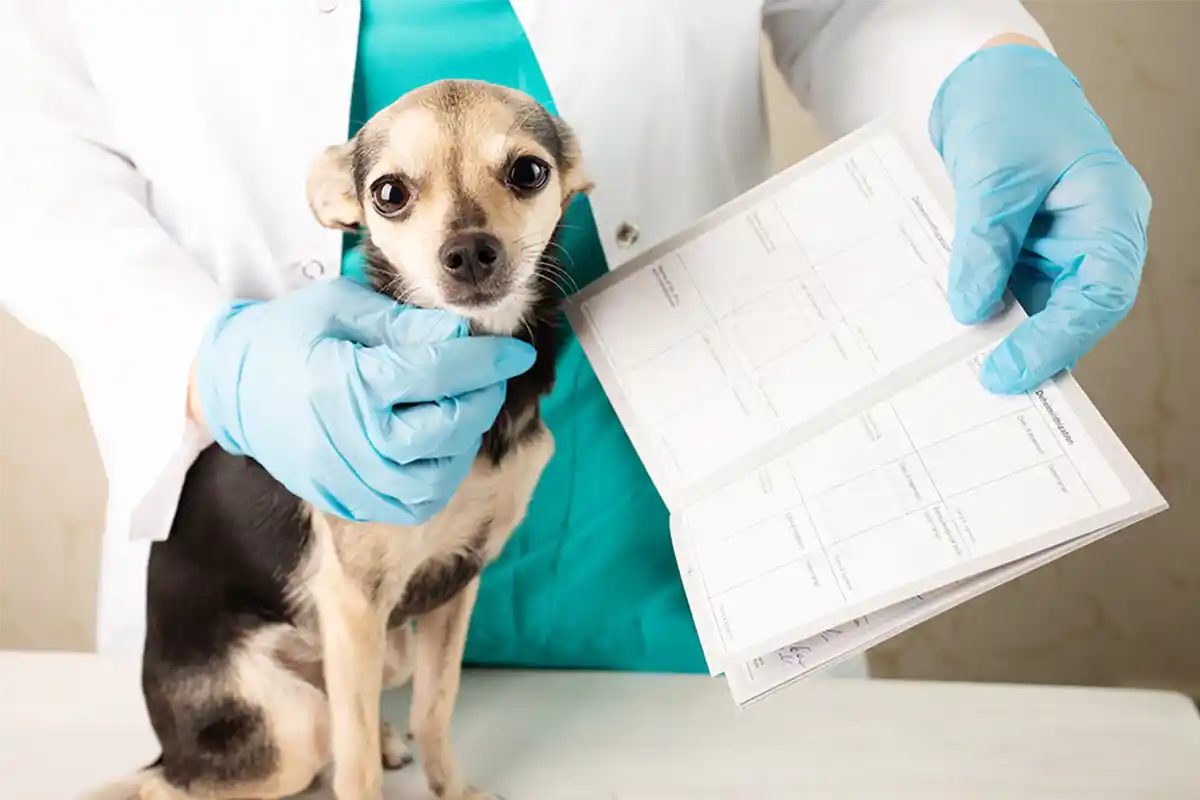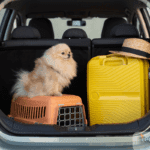An emergency can strike at any time. Learn the 5 critical components of a dog emergency plan so you can keep your canine companion safe and feel prepared.
When every second matters, being prepared can save your dog’s life. At Tailwaggors, we understand the deep bond you share with your canine companion, and as a veterinarian with over nine years of emergency medicine expertise, I’ve witnessed firsthand how preparation can turn a crisis into a manageable situation. Yet, a recent survey revealed that 72% of dog owners lack a comprehensive emergency plan. That’s why we’ve crafted this professional guide, backed by leading veterinary standards, to ensure you’re equipped to act decisively and protect your beloved pet when the unexpected strikes.
Let’s work together to build a safer, more secure environment for your dog—because their safety is worth every effort. For additional safety tips tailored to dogs, explore The Ultimate Guide to Dog-Proofing Your Home: Vet-Approved Solutions (2025).
When you have an emergency plan in place, you’re not just reacting—you’re leading your dog to safety with confidence,” says Dr. Esther Knoetze (BSc, BVSc), veterinarian and emergency care expert.
- • Expert-validated protocols: Emergency preparation made easy
- • Professional guidance: Immediate response actions for common emergencies
- • Comprehensive checklist: Essential emergency kit items tailored to dogs
- • Step-by-step framework: Easy implementation
- • Resources & templates: Downloadable materials
1. Build Your Professional Emergency Response Network
Emergency veterinary care for dogs requires a coordinated network of professionals ready to act at a moment’s notice. Here’s how to build your dog’s emergency response team:
Primary Care Team
- Primary Veterinarian: Your first line of defense for routine and urgent care.
- 24/7 Emergency Hospital: Identify the nearest facility certified by the American Animal Hospital Association (AAHA).
- Mobile Veterinary Service: Essential for emergencies when transport isn’t possible.
Secondary Support Network
- Professional Dog Walker or Sitter: Ensure they are certified and trained in emergency protocols.
- Trusted Neighbor: Someone within 5-10 minutes of your home who is familiar with your dog.
- Family Member: A person who knows your dog’s medical history and behavioral tendencies.
Professional Tip: “Create a shared digital document with your emergency contacts that includes your dog’s medical history, current medications, and behavioral notes. Update it after every vet visit.” – Dr. Esther Knoetze (BSc)(BVSc)
Setting Up Your Emergency Communication Protocol
Establish a clear chain of communication to ensure quick coordination during emergencies:
- Create an emergency contact card for your wallet and dog’s carrier.
- Program ICE (In Case of Emergency) numbers in your phone with notes about your dog.
- Set up a group chat or shared digital document for rapid communication among your support network.
- Display emergency contact information in visible areas of your home, such as on the fridge or near your dog’s bed.
How to Compile Your Emergency Network
Create a comprehensive emergency document that includes:
- Contact details for your primary veterinarian and nearest emergency hospital.
- Information for your pet sitter, trusted neighbors, and two backup contacts.
Store this document in three key locations:
- Your dog’s emergency kit (in a waterproof sleeve).
- Your phone’s ICE folder.
- A visible spot near your dog’s crate or carrier.
Having a well-organized and easily accessible emergency network ensures that when every minute counts, you’re prepared to act confidently and protect your dog. Regular checkups with your veterinarian can reduce emergency risks by addressing potential health issues early.
Learn more about First Aid for Pets: What Every Pet Owner Should Know.
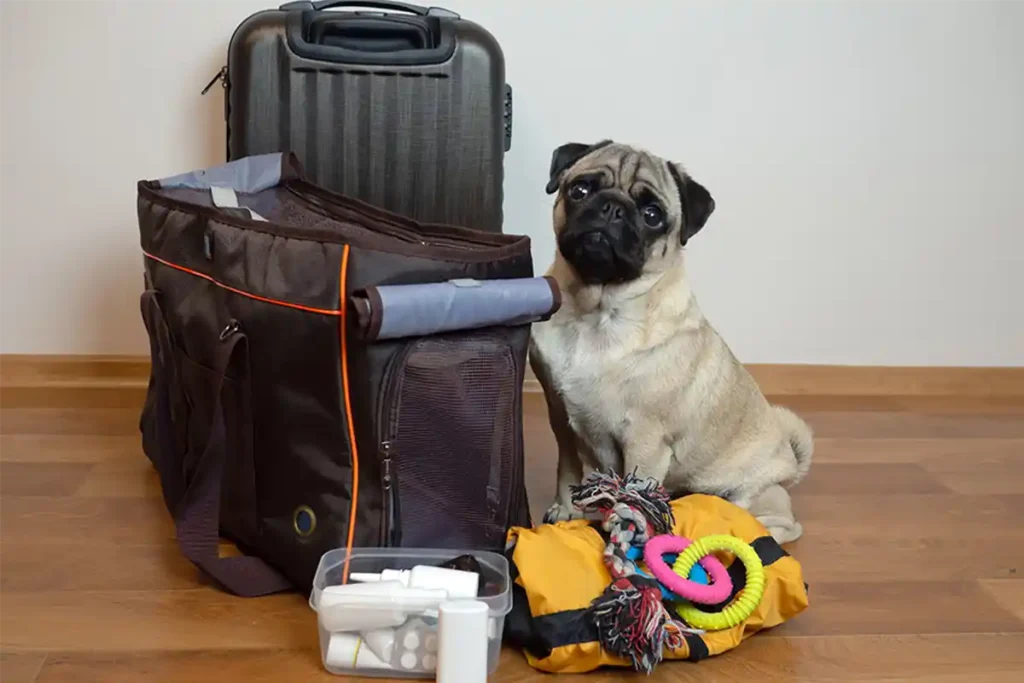
2. Build a Professional Dog Emergency Kit
Essential Medical Supplies
Your dog’s emergency kit requires medical supplies that meet veterinary standards. Based on protocols from the American Veterinary Medical Association (AVMA), your kit should include:
- 1 Sterile gauze pads (4×4 inch)
- 2 Self-adhering veterinary wrap (avoid human bandages)
- 3 Styptic powder for nail bleeding
- 4 Saline wound flush (sterile)
- 1 Digital thermometer (specifically for pets)
- 2 Small flashlight for examining gums
- 3 Disposable gloves (nitrile preferred)
- 1 7-day pill organizer for regular medications
- 2 Copies of current prescriptions
- 3 Medication administration tools (pill pockets, syringes)
Clinical Note: “Never use human medications without veterinary approval. What’s safe for humans can be lethal for dogs.” – Dr. Esther Knoetze
Survival Essentials
Nutrition and Hydration (7-Day Supply)
- 1 Dry food in waterproof container
- 2 Wet food with pop-top lids
- 3 Familiar treats for medication administration
- 1 1 gallon per cat per day (7-day supply)
- 2 Collapsible water bowls
- 3 Water purification tablets
- 1 Waste disposal bags
- 2 Small shovel for outdoor waste management
- 3 Sanitizing wipes
Documentation Portfolio
Create a waterproof emergency documentation kit including:
- 1 Recent photos of your dog (updated quarterly)
- 2 Medical history and vaccination records
- 3 Microchip registration details
- 4 Insurance policy information
- 5 Emergency treatment authorization form
Comfort and Stress Management
Reduce trauma during emergencies with:
- 1 Familiar bedding (small, washable piece)
- 2 Comfort items with home scents
- 3 Favorite toy
- 4 Anxiety wraps or calming shirts (e.g., Thundershirt)
- 5 Veterinary-approved calming pheromone spray
Wearable Accessories
- 1 Collar
- 2 6-foot leash
- 3 Harness
- 4 Muzzle
- 5 ID tag
Cleaning Supplies
- 1 Dish liquid
- 2 Disinfectant
- 3 Garbage bags
- 4 Paper towels
Kit Maintenance Protocol
- 1 Verify medication expiration dates
- 2 Rotate food and water supplies
- 3 Update documentation as needed
- 1 Replace expired items
- 2 Update photos and medical records
- 3 Check integrity of containers
- 4 Test all equipment
- 1 Complete replacement of all perishables
- 2 Full inventory check against master list
- 3 Update all documentation
- 4 Review and update emergency protocols
Professional Insight: “Create two identical kits – one for home and one for your car. In true emergencies, you may not be able to return home.” – Dr. Esther Knoetze
Emergency Kit Storage Requirements
Store your kit according to these veterinary guidelines:
- 1 Temperature-controlled environment (65-75°F)
- 2 Easily accessible location
- 3 Protected from moisture and pests
- 4 Near evacuation route
- 5 Together with carrier and harness
Taking Action: Building Your Professional Emergency Kit
A comprehensive emergency kit serves as your lifeline during a crisis. Following veterinary protocols, assemble your kit with five essential components: medical supplies for immediate care, survival necessities for a 7-day period, a complete documentation portfolio, comfort items to reduce stress, and proper storage solutions.
Store your fully-stocked kit in a temperature-controlled location (65-75°F) near your evacuation route, alongside your dog’s leash, harness, and carrier. Remember to follow the maintenance schedule – monthly checks of perishables, quarterly reviews of all supplies, and annual complete overhauls.
Expert Insight: “In my experience, having an emergency kit ready has saved countless dogs during crises. A client once used their prepared kit to stabilize their dog’s injury during a flood, buying precious time until help arrived,” – says Dr. Esther Knoetze (BSc, BVSc).

3. Choosing and Using the Right Emergency Carrier
Your dog’s carrier isn’t just a travel accessory—it’s a critical piece of safety equipment that can safeguard your dog’s life in emergencies. Think of it as your dog’s personal evacuation vehicle. Here’s what you need to know about selecting, preparing, and using a carrier effectively.
Picking the Right Carrier
When choosing an emergency carrier for your dog, prioritize the following features to ensure safety, comfort, and durability:
- Hard-Sided and Durable: Hard-sided carriers offer better protection during sudden impacts or accidents compared to soft-sided alternatives.
- Crash-Tested for Safety: Look for carriers certified for car travel to minimize risks during sudden stops or collisions.
- Dual Access: Carriers with both top and front doors make it easier to load or unload your dog during stressful situations.
- Secure Locking Mechanisms: Ensure the latches are strong enough to prevent accidental openings.
- Ventilation on All Sides: Proper airflow helps keep your dog calm and comfortable during transport.
- Comfortable Carrying Handles: Padded or ergonomic handles make it easier to carry the carrier for longer distances.
- Non-Slip Base: A stable, non-slip bottom prevents the carrier from sliding during transport.
Size Considerations
Choosing the right size is crucial for your dog’s safety and comfort:
- Avoid Excess Space: A carrier that’s too large can cause your dog to slide around, increasing stress or risk of injury.
- Right Size for Comfort: The carrier should be large enough for your dog to stand, turn around, and lie down comfortably without feeling cramped.
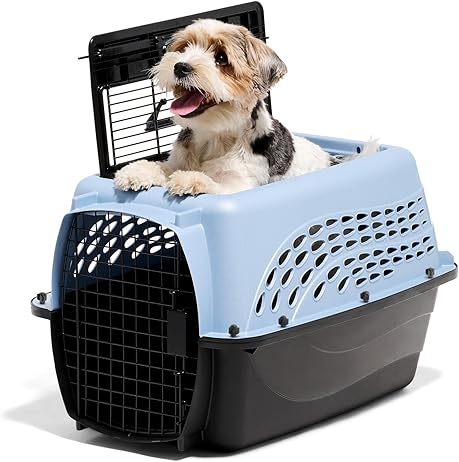
- Price: Check on Amazon
- Rating: 4.7/5 (12,524 reviews)
- Top-loading and front-loading for convenience
- Durable and airline-approved design

- Price: Check on Amazon
- Rating: 4.5/5 (6,971+ reviews)
- Durable, crash-tested, airline-approved
- Ideal for medium to large breeds
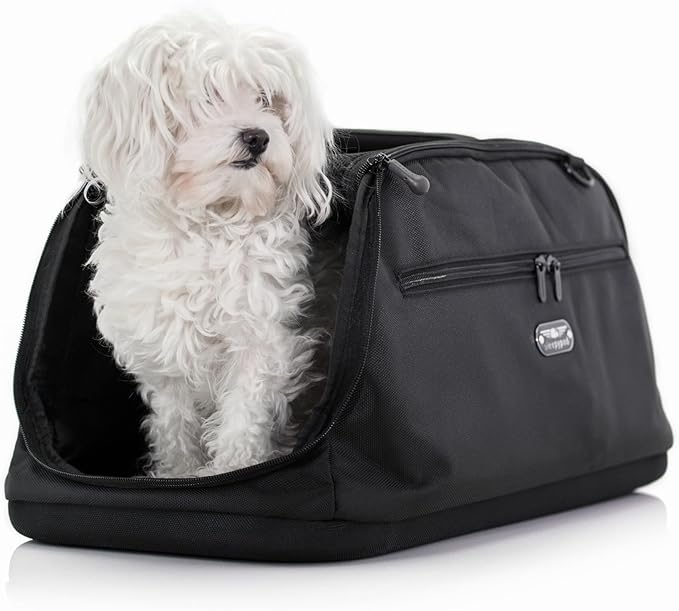
- Price: Check on Amazon
- Rating: 4.7/5 (704 reviews)
- Compact, crash-tested, airline-approved
- Includes plush interior bedding
- Permanent ID Plate: Attach a metal ID plate with your contact details to the carrier.
- Waterproof Pouch: Include medical records, vaccination history, and an emergency contact list.
- Reflective Tape: Add reflective strips for visibility in low-light conditions.
- Current Photo: Place a clear photo of your dog in the carrier for easy identification.
- Week 1: Make the carrier a piece of furniture
- Week 2: Turn it into a treat and meal spot
- Week 3: Practice short closure periods
- Week 4: Start movement training
- Check all parts for wear
- Clean thoroughly
- Update information
- Replace bedding if needed
- Store near your exit, next to your emergency kit
- Turn carrier door-up
- Support your dog’s whole body
- Lower them in backward
- Close door quickly but gently
- Turn carrier horizontal
Bringing It All Together
Your dog’s carrier can make all the difference during an emergency. Selecting the right carrier, maintaining it properly, and training your dog to feel safe inside ensures you’ll be prepared for any situation. As Dr. Esther Knoetze advises:
“The best emergency carrier is one your dog willingly enters and feels secure in. This comes from choosing the right carrier and helping your dog see it as a safe haven.
Learn how to recognize critical signs requiring immediate vet care during transport emergencies.
Quick Tip: “Keep a leash, a folded blanket, and a few treats stored on top of your carrier. These small additions can make loading your dog much easier in stressful situations.” – Dr. Esther Knoetze (BSc, BVSc)
4. Ensure Clear Identification
Emergencies significantly increase the risk of separation from your dog, making clear identification essential. According to the American Veterinary Medical Association (AVMA), one in three pets will get lost during their lifetime. Microchipping is the most reliable form of identification, as tags can fall off or become hard to read over time. Dr. Esther Knoetze emphasizes:
AVMA tip: “A study of shelters revealed that microchipped dogs were twice as likely to be returned to their families compared to non-microchipped dogs.” – Dr. Esther Knoetze (BSc, BVSc)
If your dog isn’t microchipped, schedule an appointment with your veterinarian immediately. Microchips provide a permanent identification method and are invaluable in emergencies. However, they only work if your contact information is up to date. Ensure your microchip registration includes:
- Your Current Phone Number: Add a backup contact if possible.
- Home Address: Useful if your dog is found locally.
- Email Address: For quick communication.
✨ Pro Tip: Check your microchip registry details annually to ensure everything is accurate and up-to-date.
While microchips are vital, collars and ID tags remain your dog’s first line of visible identification. Ensure your dog wears a sturdy collar with:
- Your Dog’s Name: Makes it easier for strangers to address them.
- Your Contact Number: Include a mobile number for rapid reach.
- Medical Needs: Mention conditions like diabetes or allergies.
✨ Pro Tip: Use reflective collars to increase visibility at night or in low-light conditions.
Prepare a small ID kit as part of your dog’s emergency gear. Include:
- Recent Photos of Your Dog: Update quarterly and ensure they include distinguishing marks.
- Copies of Vaccination Records: Proof of health status if needed.
- Proof of Ownership: Such as adoption papers or AKC registration.
- QR Code Tags: Link these to an online profile with detailed information about your dog.
✨ Expert Insight: “In one instance, a microchip helped a client reunite with their dog after it was displaced during a hurricane. This small chip made a huge difference,” says Dr. Esther Knoetze (BSc, BVSc).
Consider digital identification tools for added security:
- GPS Collars or Trackers: Allow real-time location tracking.
- Online Pet Profiles: Platforms like PetHub link QR tags to a digital profile with your dog’s information.
- Pet Recovery Services: Register your dog with services like HomeAgain for professional assistance in locating lost pets.
Clear and current identification is your dog’s lifeline in emergencies. A microchip, paired with an up-to-date collar and ID tags, ensures they can be quickly returned to you if separated. If you’re welcoming a new dog, setting up proper identification is crucial from the start.
As Dr. Esther Knoetze advises:
“The best identification system is one that combines permanent microchipping with visible, easy-to-read tags. Together, these tools provide your dog with the best chance of being reunited with you in a crisis.”
✨ Quick Tip: “Store a spare collar and tag in your emergency kit for backup. Simple preparation can make a world of difference during an evacuation,” says Dr. Esther Knoetze (BSc, BVSc).
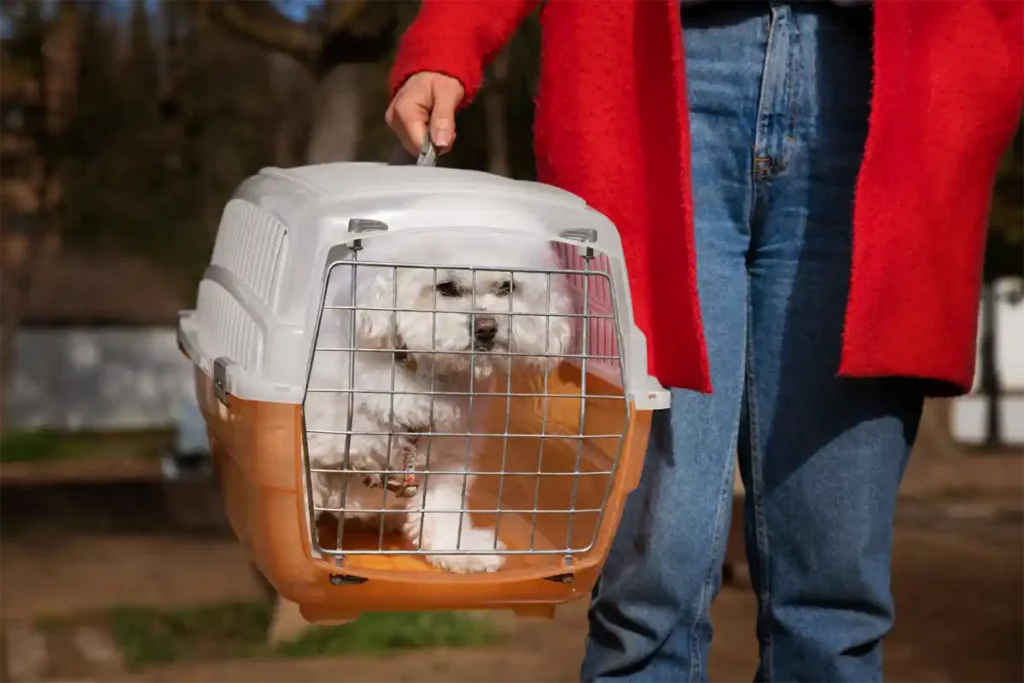
5. Practice Your Emergency Plan
Success in emergencies comes from preparation, muscle memory, and confident action. Just like fire drills at school, practicing your emergency plan helps you and your dog stay calm and act effectively when emergencies strike.
The cornerstone of any effective emergency strategy is practice. Schedule regular emergency drills to train your dog to respond to commands, secure them in their carrier, and grab your supply kit efficiently. Dr. Esther Knoetze (BSc, BVSc) advises:
Expert Tip: “Practice loading your dog into their carrier calmly and swiftly. Use positive reinforcement, like high-value treats, to build a positive association.”
Real-World Practice Opportunities
ncorporate training into routine activities to reinforce emergency preparedness. These moments provide excellent opportunities:
- Vet Visits: Use the carrier during routine checkups so your dog becomes comfortable with it.
- Grooming Appointments: Practice travel and handling as if preparing for an emergency.
- Home Maintenance Checks: Simulate evacuations during household inspections or repairs.
- Fire Alarm Drills: Conduct a full emergency simulation during fire alarm testing days.
Ensure you have digital and physical copies of your emergency plan available for easy access. Review the plan with family members and your pet sitter regularly to ensure everyone understands their roles.
By practicing these five critical components, you’ll have a comprehensive dog emergency plan tailored to your household and pet’s unique needs. Share the plan with all emergency contacts and post it in a visible location in your home. Proactive preparation gives you the confidence to protect your beloved dog in any situation. As Dr. Esther Knoetze shares:
“In emergencies, preparation is key. I’ve seen firsthand how practiced plans can make the difference between chaos and calm.”
Expert Q&A: Dog Emergency Guide
Dr. Esther Knoetze answers your critical questions about dog emergencies and preparation.
Critical warning signs requiring immediate veterinary attention:
- Difficulty breathing or persistent coughing
- Severe trauma or visible fractures
- Repeated vomiting or diarrhea with blood
- Seizures or unconsciousness
Essential emergency kit contents recommended by veterinarians:
- Digital thermometer (normal: 101-102.5°F)
- Saline solution for wound cleaning
- Gauze, bandages, and adhesive tape
- Leash, harness, and collapsible water bowl
ASPCA Poison Control critical warning signs:
- Sudden drooling or foaming
- Vomiting or diarrhea
- Seizures or tremors
- Lethargy or collapse
Veterinary-approved transportation protocol:
- Use a secure, sturdy carrier or stretcher.
- Support the neck and spine when lifting.
- Minimize movement to prevent further injury.
- Keep the dog calm and warm during transport.
ASPCA emergency response protocol:
- Identify the substance and secure any packaging.
- Contact a pet poison hotline immediately.
- Do not induce vomiting unless instructed by professionals.
- Monitor breathing and alertness closely.
Critical heat emergency symptoms:
- Excessive panting or drooling
- Bright red gums or tongue
- Disorientation or weakness
- Collapse or unconsciousness
Emergency seizure protocol:
- Clear the area of hazards.
- Note the start time and duration of the seizure.
- Avoid touching the dog\u2019s mouth.
- Record the seizure for your vet if possible.
Emergency choking protocol:
- Check for visible obstructions.
- Perform the Heimlich maneuver if trained.
- Keep the dog calm and seek immediate vet care.
- Never force objects from the throat without professional help.
Final Note: “Emergency preparation isn’t about fear – it’s about empowerment. Every practice session is an investment in your dog’s safety and your peace of mind.”
Share Your Dog’s Emergency Preparedness Story!
We’d love to hear how you’ve prepared for emergencies with your dog. Share your top tips, memorable moments, or lessons learned in the comments section below. Join us on social media for more expert advice, practical guides, and updates on keeping your dog safe and healthy in any situation. Need help? Contact Tailwaggors for trusted resources and support.
🐾 Love dogs as much as we do? 🐶
Share this guide with fellow dog owners and help them discover everything they need to keep their dogs safe, happy, and healthy. Forward it now! 📬


